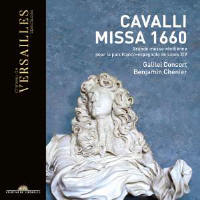Texte paru dans: / Appeared in: |
|
|
Reviewer: Bertil
van Boer In the history of music, Francesco Cavalli occupies an important position as the successor to Claudio Monteverdi as the doyen of Venetian opera. His reputation for stage music was unparalleled for the mid-17th century, but by 1660 he faced two issues: rivalry with Pietro Marc’antonio Cesti and advancing age. He was comfortably settled in as a famed composer of operas, not to mention a secure post as organist at St. Mark’s. But as these issues came to the fore, he decided that a change would help revive his creative juices and put his erstwhile rival in his place. A commission from France was just the ticket, and negotiating the retention of his position in Venice as organist, he set out to accept it. The go-between was the conniving Cardinal Mazarin, and even though it was a diplomatic event, the marriage between the future Louis XIV and Spanish princess Maria Theresa, the musical celebrations were arranged in grand style for Cavalli. Fortunately, the composer had at his command his own raft of singers, as well as possibly instrumentalists, from Venice, who had come to Paris to sing during the Carnival season, and so all of the stars aligned to make this a signal event.
Cavalli had extensive experience as a composer of sacred music, even publishing in 1656 a complete service, including a musical Mass. As organist at St. Mark’s, moreover, he wrote for the services, earning him a reputation as the successor to the golden age of the Gabrielis. Unfortunately, only sparse examples of what must have been a significant body of sacred music have survived. Even the festivities of 1660 in France, though described in the documentary sources in detail, did not leave behind manuscript traces, and therefore Benjamin Chénier had to cobble together material from Cavalli’s published works in order to mimic what must have been a grand set of new compositions. No matter, since he has chosen to duplicate Cavalli’s large ensemble that included full strings, a cornett and trombone choir, and even a trumpet and drum for the fanfares.
The result is impressive, especially with the opening brass intrada. It reeks of royal privilege, and the rolling drums are especially powerful and regal. Of course, Cavalli didn’t actually write this (it comes from an anonymous source), nor did he compose the intricate contrapuntal toccata that follows. Both are integral to the ambience of the work, however. The Ordinary movements are all taken from the 1656 publication and were originally composed for Venice. The Kyrie has a stately opening ritornello, followed by a majestic homophonic chorus. The long Gloria opens with a joyous leaping of solo voices, almost like a madrigal but with more resonance, and when the chorus enters with expostulations the effect is grand. The Credo is an exclamation of faith, with imitative figures cascading about the proclamation of belief. The more solemn Et incarnatus est is soft and mysterious without losing the warm and embracing choral sound, even as it kaleidoscopically changes harmonies, and the Crucifixus is characterized by extremely gnarly harmonies and dissonances in imitative polyphony. The Sanctus and Agnus Dei both retain the powerful royal style, moving slowly and inexorably towards their pompous homophonic close. Of the other portions of the Mass, perhaps the most effective is the mysterious Bone Jesu, where the voices weave in and out of each other above a slowly unfolding set of harmonies, and the Laudate Jerusalem, taken from the 1675 Vespers, in which an incipit of chant devolves into imitative choral statements. The Elevatio seems like it is made up of cannon fire from the drums, and subsequently a slowly unfolding set of organ harmonies that are again mysterious and ghostly. A final fanfare concludes the work (though the Laudate Jerusalem comes afterwards).
As a
program goes this is appropriately stately, something that would have been
entirely appropriate for the celebratory occasion. Even though it is not
precisely what was performed at the time, it nonetheless gives one a glimpse
into the world of French political grandeur, and at the same time
demonstrates that Cavalli was both versatile and creative in his sacred
musical endeavors. The performance itself reflects this power, with
excellent work by the Galilei Consort. My only quibble would be that the
entire disc sounds as if it was recorded in the French state washroom, with
overly live reverberation. But that was probably the soundscape of the
original, and the music itself certainly does not warrant a lesser or more
intimate setting. All in all, this is a fine disc, though one should
remember that it is only a taste of what the 1660 original was like. | |
|
|
|
|
|
|
|
Cliquez l'un ou l'autre
bouton pour découvrir bien d'autres critiques de CD |
|




